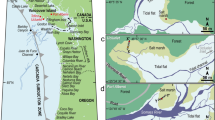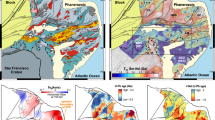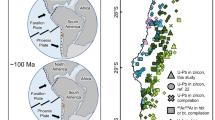Abstract
The Sauk transgression was one of the most dramatic global marine transgressions in Earth history. It is recorded by deposition of predominantly Cambrian non-marine to shallow marine sheet sandstones unconformably above basement rocks far into the interiors of many continents. Here we use dating of detrital zircons sampled from above and below the Great Unconformity in the Grand Canyon region to bracket the timing of the Sauk transgression at this classic location. We find that the Sixtymile Formation, long considered a Precambrian unit beneath the Great Unconformity, has maximum depositional ages that get younger up-section from 527 to 509 million years old. The unit contains angular unconformities and soft-sediment deformation that record a previously unknown period of intracratonic faulting and epeirogeny spanning four Cambrian stages. The overlying Tapeats Sandstone has youngest detrital zircon ages of 505 to 501 million years old. When linked to calibrated trilobite zone ages of greater than 500 million years old, these age constraints show that the marine transgression across a greater than 300-km-wide cratonic region took place during an interval 505 to 500 million years ago—more recently and more rapidly than previously thought. We redefine this onlap as the main Sauk transgression in the region. Mechanisms for this rapid flooding of the continent include thermal subsidence following the final breakup of Rodinia, combined with abrupt global eustatic changes driven by climate and/or mantle buoyancy modifications.
This is a preview of subscription content, access via your institution
Access options
Access Nature and 54 other Nature Portfolio journals
Get Nature+, our best-value online-access subscription
$29.99 / 30 days
cancel any time
Subscribe to this journal
Receive 12 print issues and online access
$259.00 per year
only $21.58 per issue
Buy this article
- Purchase on Springer Link
- Instant access to full article PDF
Prices may be subject to local taxes which are calculated during checkout


Similar content being viewed by others
References
Hoffman, P. F. & Schrag, D. P. The snowball Earth hypothesis: testing the limits of global change. Terra Nova 14, 129–155 (2002).
Canfield, D. E., Poulton, S. W. & Narbonne, G. M. Late-Neoproterozoic deep-ocean oxygenation and the rise of animal life. Science 315, 92–95 (2007).
Smith, M. P. & Harper, D. A. T. Causes of the Cambrian explosion. Science 341, 1355–1356 (2013).
Macdonald, F. A. et al. Calibrating the Cryogenian. Science 327, 1241–1243 (2010).
Rooney, A. D., Strauss, J. V., Brandon, A. D. & Macdonald, F. A. A Cryogenian chronology: two long-lasting, synchronous Neoproterozoic glaciations. Geology 43, 459–462 (2015).
Dalziel, I. W. D. Cambrian transgression and radiation linked to an Iapetus-Pacific oceanic connection? Geology 42, 979–982 (2014).
Merdith, A. S. et al. A full-plate global reconstruction of the Neoproterozoic. Gondwana Res. 50, 84–134 (2017).
Karlstrom, K. E. et al. Chuar Group of the Grand Canyon: record of breakup of Rodinia, associated change in the global carbon cycle, and ecosystem expansion by 740 Ma. Geology 28, 619–622 (2000).
MacDonald, F. A. et al. The Laurentian record of Neoproterozoic glaciation, tectonism, and eukaryotic evolution in Death Valley, California. Geol. Soc. Am. Bull. 125, 1203–1223 (2013).
Bond, G. C., Christie-Blick, N., Kominz, M. A. & Devlin, W. J. An Early Cambrian rift to post-rift transition in the Cordillera of western North America. Nature 315, 742–746 (1985).
Levy, M. & Christie-Blick, N. Tectonic subsidence of the early Paleozoic passive continental margin in eastern California and southern Nevada. Geol. Soc. Am. Bull. 103, 1590–1606 (1991).
Peters, S. E. & Gaines, R. R. Formation of the ‘Great Unconformity’ as a trigger for the Cambrian explosion. Nature 484, 363–366 (2012).
Sloss, L. Sequences in the cratonic interior of North America. Geol. Soc. Am. Bull. 74, 93–114 (1963).
Keller, M., Lehnert, O. & Cooper, J. D. Sauk megasequence supersequences, southern Great Basin: second-order accommodation events in the southwest Cordilleran margin platform. AAPG Mem. 98, 873–896 (2012).
Babcock, L. E. et al. Global climate, sea level cycles, and biotic events in the Cambrian Period. Palaeoworld 24, 5–15 (2015).
International Chronostratigraphic Chart v.2017/02 (International Commission on Stratigraphy, 2017); http://www.stratigraphy.org/ICSchart/ChronostratChart2017-02.pdf
Powell, J. W. Exploration of the Colorado River of the West and Its Tributaries (Smithsonian Institution, 1875).
Dehler, C. et al. Synthesis of the 780–740 Ma Chuar, Uinta Mountain, and Pahrump (ChUMP) groups, western USA: implications for Laurentia-wide cratonic marine basins. Geol. Soc. Am. Bull. 129, 607–624 (2017).
Elston, D. P. & McKee, E. H. Age and correlation of the late Proterozoic Grand Canyon disturbance, northern Arizona. Geol. Soc. Am. Bull. 93, 681–699 (1982).
Timmons, J. M. et al. Proterozoic multistage (ca. 1.1 and 0.8 Ga) extension recorded in the Grand Canyon Supergroup and establishment of northwest-and north-trending tectonic grains in the southwestern United States. Geol. Soc. Am. Bull. 113, 163–181 (2001).
McKee, E. D. & Resser, C. E. Cambrian History of the Grand Canyon Region Pub. 563 (Carnegie Institution of Washington, The Lord Baltimore Press, Baltimore, 1945).
Spencer, C. J., Prave, A. R., Cawood, P. A. & Roberts, N. M. W. Detrital zircon geochronology of the Grenville/Llano foreland and basal Sauk sequence in west Texas, USA. Geol. Soc. Am. Bull. 126, 1117–1128 (2014).
Palmer, A. R. Subdivision of the Sauk Sequence Open-file Report No. 81-743 160–162 (US Geological Survey,1981).
Ford, T. D. & Breed, W. J. Late Precambrian Chuar Group, Grand Canyon, Arizona. Geol. Soc. Am. Bull. 84, 1243–1260 (1973).
Elston, D. P. Late Precambrian Sixtymile Formation and Orogeny at Top of the Grand Canyon Supergroup, Northern Arizona Professional Paper 1092 (US Geological Survey, 1979).
Rooney, A.D. Coupled Re-Os and U-Pb geochronology of the Tonian Chuar Group, Grand Canyon. Geol. Soc. Am. Bull. https://doi.org/10.1130/B31768.1 (2017).
Hagadorn, J. W., Kirschvink, J. L., Raub, T. D. & Rose, E. C. in Cambrian Stratigraphy and Paleontology of Northern Arizona and Southern Nevada (eds Hollingsworth, J. S. et al.) 63–77 (MNA Bulletin 67, Museum of Northern Arizona, 2011).
Webster, M. in Cambrian Stratigraphy and Paleontology of Northern Arizona and Southern Nevada (eds Hollingsworth, J. S. et al.) 122–154 (MNA Bulletin 67, Museum of Northern Arizona, 2011).
Amato, J. M. & Mack, G. H. Detrital zircon geochronology from the Cambrian-Ordovician Bliss Sandstone, New Mexico: evidence for contrasting Grenville-age and Cambrian sources on opposite sides of the Transcontinental Arch. Geol. Soc. Am. Bull. 124, 1826–1840 (2012).
Hanson, R. E. et al. Intraplate magmatism related to opening of the southern Iapetus Ocean: Cambrian Wichita igneous province in the Southern Oklahoma rift zone. Lithos 174, 57–70 (2013).
Fedo, C. M. & Cooper, J. D. Sedimentology and sequence stratigraphy of Neoproterozoic and Cambrian units across a craton-margin hinge zone, southeastern California, and implications for the early evolution of the Cordilleran margin. Sed. Geol. 141–142, 501–522 (2001).
Stewart, J. H. et al. Detrital zircon provenance of Mesoproterozoic to Cambrian arenites in the western United States and northwestern Mexico. Geol. Soc. Am. Bull. 113, 1343–1356 (2001).
Rose, E. Nonmarine aspects of the Cambrian Tonto Group of the Grand Canyon, USA, and broader implications. Palaeoworld 15, 223–241 (2012).
Gehrels, G. E. et al. Detrital zircon U-Pb geochronology of Paleozoic strata in the Grand Canyon. Lithosphere 3, 183–200 (2011).
Matthews, W., Guest, B. & Madronich, L. Latest Neoproterozoic to Cambrian detrital zircon facies of western Laurentia. Geosphere 14, 243–264 (2017).
Giallorenzo et al. Timing of exhumation, Wheeler Pass thrust sheet, southern Nevada and California: Late Jurassic to middle Cretaceous evolution of the southern Sevier fold-and-thrust belt. Geol. Soc. Am. Bull. 130, 558–579 (2017).
Sundberg, F. A. in Cambrian Stratigraphy and Paleontology of Northern Arizona and Southern Nevada (eds Hollingsworth, J. S. et al.) 186–190 (MNA Bulletin 67, Museum of Northern Arizona, 2011).
Foster, J. Trilobites and other fauna from two quarries in the Bright Angel Shale (middle Cambrian, Series 3, Delamaran), Grand Canyon National Park, Arizona. Mus. North. Ariz. Bull. 67, 99–120 (2011).
Schmitz, M. D. in The Geologic Time Scale 2012 (eds Gradstein, F. M. et al.) 1045–1082 (Elsevier, Boston, 2012).
Sundberg, F. A. et al. International correlation of the Cambrian Series 2–3, Stages 4–5 boundary interval. Australas. Palaeontol. Mem. 49, 83–124 (2016).
Peng, S., Babcock, L. E. & Cooper, R. A. in The Geologic Time Scale 2012 (eds Gradstein, F.M. et al.) 437–488 (Elsevier, Boston, 2012).
Encarnacion, J., Rowell, A. J. & Grunow, A. M. A U-Pb age for the Cambrian Taylor Formation, Antarctica: implications for the Cambrian time scale. J. Geol. 107, 497–504 (1999).
Colpron, M., Logan, J. M. & Mortensen, J. K. U-Pb zircon age constraint for late Neoproterozoic rifting and initiation of the lower Paleozoic passive margin of western Laurentia. Can. J. Earth Sci. 39, 133–143 (2002).
Yonkee, W. A. et al. Tectono-stratigraphic framework of Neoproterozoic to Cambrian strata, west-central US: protracted rifting, glaciation, and evolution of the North American Cordilleran margin. Earth Sci. Rev. 136, 59–95 (2014).
Dickinson, W. R. Evolution of the North America Cordillera. Annu. Rev. Earth Planet. Sci. 32, 13–45 (2004).
Hogan, E. G., Fedo, C. M. & Cooper, J. D. Reassessment of the basal Sauk supersequence boundary across the Laurentian craton-margin hinge zone, southeastern California. J. Geol. 119, 661–685 (2011).
Landing, E., Amati, L. & Franzi, D. A. Epeirogenic transgression near a triple junction: the oldest (latest early-middle Cambrian) marine onlap of cratonic New York and Quebec. Geol. Mag. 146, 552–566 (2009).
Powell, J. H., Abed, A. M. & Le Nindre, Y.-M. Cambrian stratigraphy of Jordan. GeoArabia 19, 81–134 (2014).
Maidment, D. W., Williams, I. S. & Hand, M. Testing long-term patterns of basin sedimentation by detrital zircon geochronology, Centralian Superbasin, Australia. Basin Res. 19, 335–360 (2007).
Meyers, S. R. & Peters, S. E. A 56 million year rhythm in North American sedimentation during the Phanerozoic. Earth Planet. Sci. Lett. 303, 174–180 (2011).
Kirschvink, J. L., Ripperdan, R. L. & Evans, D. A. Evidence for a large-scale reorganization of Early Cambrian continental masses by inertial interchange true polar wander. Science 277, 541–545 (1997).
Driscoll, P. Simulating 2 Ga of geodynamo history. Geophys. Res. Lett. 43, 5680–5687 (2016).
Gehrels, G. E. & Pecha, M. Detrital zircon U-Pb geochronology and Hf isotope geochemistry of Paleozoic and Triassic passive margin strata of western North America. Geosphere 10, 49–65 (2014).
Daniels, B. G., Auchter, N. C., Hubbard, S. M., Romans, B. W., Matthews, W. A. & Stright, L. Timing of deep-water slope evolution constrained by large-n detrital and volcanic ash zircon geochronology, Cretaceous Magallanes Basin, Chile. Geol. Soc. Am. Bull. 130, 438–454 (2018).
Paces, J. B. & Miller, J. D. Precise U-Pb ages of Duluth Complex and related mafic intrusion, Northeastern Minnesota: geochronological insights to physical, petrogenetic, paleomagnetic, and tectonomagmatic processes associated with the 1.1 Ga Midcontinent Rift System. J. Geophys. Res. 98, 13997–14013 (2003).
Wiedenbeck et al. Further characterisation of the 91500 zircon crystal. Geostand. Geoanal. Res. 28, 9–39 (2004).
Mortensen, J. K. & Card, K. D. U-Pb age constraints for the magmatic and tectonic evolution of the Pontiac Subprovince, Quebec. Can. J. Earth Sci. 30, 1970–1980 (1993).
Black, L. P. et al. Improved 206Pb/238U microprobe geochronology by the monitoring of trace-element-related matrix effects; SHRIMP, ID-TIMS, ELA-ICP-MS and oxygen isotope documentation for a series of zircon standards. Chem. Geol. 205, 155–170 (2004).
Müller, W., Shelley, M., Miller, P. & Broude, S. Initial performance metrics of a new custom-designed ArF Excimer LA-ICPMS system coupled to a two-volume laser-ablation cell. J. Anal. At. Spectrom. 24, 209–214 (2009).
Horstwood, M. S. A. et al. Community-derived standards for LA-ICP-MS U-Th-Pb geochronology – uncertainty propagation, age interpretation and data reporting. Geostand. Geoanal. Res. 40, 311–332 (2016).
Spencer, C. J., Kirkland, C. L. & Taylor, R. J. M. Strategies towards statistically robust interpretations of in situ U-Pb zircon geochronology. Geosci. Front. 7, 581–589 (2016).
Ludwig, K. R. Isoplot 3.00: a Geochronological Toolkit for Microsoft Excel Special Publication 4 (Berkeley Geochronological Center, 2003).
Matthews, W. A. & Guest, B. A practical approach for collecting large-n detrital zircon U-Pb data sets by quadrupole LA-ICP-MS. Geostand. Geoanal. Res. 41, 161–180 (2017).
Condon, D. J., Schoene, B., McLean, N. M., Bowring, S. A. & Parrish, R. R. Metrology and traceability of U-Pb isotope dilution geochronology (EARTHTIME Tracer Calibration Part I). Geochim. Cosmochim. Acta 164, 464–480 (2015).
Rivera, T. A., Storey, M., Schmitz, M. D. & Crowley, J. L. Age intercalibration of 40Ar/39Ar sanidine and chemically distinct U/Pb zircon populations from the Alder Creek Rhyolite Quaternary geochronology standard. Chem. Geol. 345, 87–98 (2013).
Siddoway, C. S. & Gehrels, G. E. Basement-hosted sandstone injectites of Colorado: a vestige of the Neoproterozoic revealed through detrital zircon provenance analysis. Lithosphere 6, 403–408 (2014).
Memeti, V. et al. Evaluating the Mojave–Snow Lake fault hypothesis and origins of central Sierran metasedimentary pendant strata using detrital zircon provenance analyses. Lithosphere 2, 341–360 (2010).
Howard, A. L., Farmer, G. L., Amato, J. M. & Fedo, C. M. Zircon U-Pb ages and Hf isotopic compositions indicate multiple sources for Grenvillian detrital zircon deposited in western Laurentia. Earth Planet. Sci. Lett. 432, 300–310 (2015).
Chapman, A. D., Ernst, W. G., Gottlieb, E., Powerman, V. & Metzger, E. P. Detrital zircon geochronology of Neoproterozoic-Lower Cambrian passive-margin strata of the White-Inyo Range, east-central California: implications for the Mojave-Snow Lake fault hypothesis. Geol. Soc. Am. Bull. 127, 926–944 (2015).
Linde, G. M., Cashman, P. H., Trexler, J. H. & Dickinson, W. R. Stratigraphic trends in detrital zircon geochronology of upper Neoproterozoic and Cambrian strata, Osgood Mountains, Nevada, and elsewhere in the Cordilleran miogeocline: evidence for early Cambrian uplift of the Transcontinental Arch. Geosphere 10, 1402–1410 (2014).
Link, P. K., Todt, M. K., Pearson, D. M. & Thomas, R. C. 500-490 Ma detrital zircons in Upper Cambrian Worm Creek and correlative sandstones, Idaho, Montana, and Wyoming: magmatism and tectonism within the passive margin. Lithosphere 9, 910–926 (2017).
Acknowledgements
Analytical support was in part from National Science Foundation (NSF) Division of Earth Sciences (EAR) grants EAR-1119629, 1145247 and 1348007 from the Tectonics Program (to K.K. and L.C.). Support for J.M. was from Australian Research Council grant FL160100168. NSF grant EAR-1338583 provided support for the Arizona LaserChron Center. Analyses conducted at the University of Calgary were obtained at the Centre for Pure and Applied Tectonics and Thermochronology, a new LA-ICP-MS laboratory funded by the Canadian Foundation for Innovation (CFI project 30696). Funding for the analytical infrastructure of the Boise State Isotope Geology Laboratory was provided by the NSF Major Research Instrumentation grants EAR-0521221 and EAR-1337887, and NSF EAR Instrumentation and Facilities Program grant EAR-0824974. We thank J. Foster, E. Rose, F. Sundberg and M. Webster for insights on fossils and facies of the Tonto Group, K. Honda for references, and patrons of the Denver Museum of Natural History for support of J.H.’s fieldwork. We thank C. Dehler for an informal review that helped improve the paper. We thank B. Guest for helping to forge the UNM-UC collaboration. Samples were collected under Research and Collecting agreements with Grand Canyon National Park.
Author contributions
K.K., J.M. and L.C. synthesized the data. J.H. contributed the palaeontology. J.H., J.M. and L.C. contributed the stratigraphy and sedimentology. G.G., J. M., M.P. and D.G. conducted the ICPMS analysis of Sixtymile Formation samples A–E. M.S. conducted CA-ID-TIMS analysis of Sixtymile Formation samples A–D. W.M. conducted the ICPMS analysis of Tapeats Sandstone samples G and H. L.M. conducted the ICPMS analysis of Grand Canyon Tapeats Standstone sample F.
Author information
Authors and Affiliations
Corresponding author
Additional information
Publisher’s note: Springer Nature remains neutral with regard to jurisdictional claims in published maps and institutional affiliations.
Supplementary information
Supplementary Information
Supplementary Figures and Supplementary Table 2 (CA-IDTIMS U-Pb isotopic data for Sixtymile Formation detrital zircons)
Supplementary Dataset 1
Supplementary Table 1 (detrital zircon data and max depositional age calculations by sample)
Rights and permissions
About this article
Cite this article
Karlstrom, K., Hagadorn, J., Gehrels, G. et al. Cambrian Sauk transgression in the Grand Canyon region redefined by detrital zircons. Nature Geosci 11, 438–443 (2018). https://doi.org/10.1038/s41561-018-0131-7
Received:
Accepted:
Published:
Issue Date:
DOI: https://doi.org/10.1038/s41561-018-0131-7



